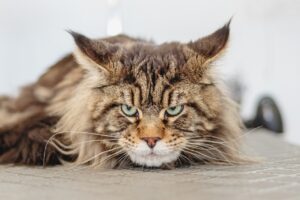I. Introduction
As caring cat owners, ensuring the health and well-being of our feline companions is paramount. One crucial aspect of feline health is the condition of their skin and coat. Scientifically formulated hypoallergenic cat food plays a pivotal role in maintaining optimal skin and coat health, providing cats with the essential nutrients they need to thrive.
By understanding the importance of nutrition in promoting healthy skin and coat, cat owners can make informed decisions about the food they offer their pets. In this article, we will explore the significance of hypoallergenic cat food, the key nutrients it contains, and its benefits for cats with skin and coat issues.
II. The Significance of Skin and Coat Health in Cats
The skin and coat are not only vital for a cat’s appearance but also serve critical functions in their overall health and well-being. A healthy skin barrier protects cats from environmental hazards such as pathogens, UV radiation, and physical injuries. Additionally, a glossy coat is often an indicator of a cat’s internal health, reflecting proper nutrition and hydration levels.
Cats with skin and coat issues may experience discomfort, itchiness, and inflammation, which can significantly impact their quality of life. By prioritizing skin and coat health, cat owners can help their pets lead happier, more comfortable lives.
III. Understanding Hypoallergenic Cat Food
Hypoallergenic cat food is specifically formulated to minimize allergic reactions and intolerances in cats with sensitivities to certain ingredients. These diets typically feature novel protein and carbohydrate sources that are less likely to trigger allergic responses, making them suitable for cats with skin and coat issues.
By eliminating common allergens such as wheat, corn, soy, and dairy, hypoallergenic cat food helps reduce the risk of adverse skin reactions and digestive upset. These diets are carefully crafted to provide balanced nutrition while avoiding potential triggers for allergic reactions.

IV. Key Nutrients for Skin and Coat Health
Several key nutrients play vital roles in promoting skin and coat health in cats. Omega-3 and omega-6 fatty acids are essential for maintaining skin integrity and reducing inflammation, helping to alleviate itchiness and irritation. These fatty acids also support a healthy coat, promoting shine and luster.
Vitamins A and E are important antioxidants that support skin cell regeneration and provide protection against oxidative damage. Additionally, zinc, selenium, and biotin play roles in maintaining skin barrier function and promoting healthy coat growth.
V. Benefits of Scientifically Formulated Hypoallergenic Cat Food
Scientifically formulated hypoallergenic cat food offers numerous benefits for cats with skin and coat issues. By providing a carefully balanced blend of nutrients, these diets help support skin barrier function, reduce inflammation, and promote a shiny, lustrous coat.
Furthermore, hypoallergenic cat food helps minimize the risk of allergic reactions and intolerances, providing relief for cats with sensitive skin and digestive systems. With continued use, these diets can help improve overall skin and coat condition, leading to happier, healthier cats.
VI. Novel Protein Sources
Hypoallergenic cat foods often utilize novel protein sources such as duck, venison, or rabbit. These alternative protein sources are less commonly used in traditional cat foods, reducing the likelihood of triggering allergic reactions in sensitive cats.
By incorporating novel protein sources into hypoallergenic diets, cat food manufacturers can provide essential amino acids necessary for healthy skin and coat function while minimizing the risk of allergic responses.
VII. Limited Ingredient Formulas
Many hypoallergenic cat foods feature limited ingredient formulas that exclude common allergens such as wheat, corn, soy, and dairy. By reducing the number of potential allergens, these diets help minimize the risk of adverse skin reactions and digestive upset in sensitive cats.
By focusing on a select few high-quality ingredients, limited ingredient formulas simplify the digestive process and reduce the likelihood of allergic reactions, allowing cats to enjoy their meals without discomfort or distress.

VIII. Balanced Omega Fatty Acid Ratios
Omega-3 and omega-6 fatty acids play essential roles in maintaining healthy skin and coat in cats. Hypoallergenic cat foods contain balanced ratios of these fatty acids to support skin barrier function, reduce inflammation, and promote a glossy, healthy coat.
By providing optimal levels of omega fatty acids, hypoallergenic cat food helps alleviate symptoms of skin irritation and itchiness, allowing cats to enjoy improved comfort and well-being.
IX. Essential Vitamins and Minerals
Vitamins and minerals are critical for maintaining skin and coat health in cats. Hypoallergenic cat foods are fortified with essential nutrients such as vitamins A, E, and D, as well as zinc, selenium, and biotin, to support skin cell turnover, protect against oxidative damage, and promote coat shine and texture.
These vitamins and minerals work synergistically to support optimal skin barrier function, reduce inflammation, and promote healthy coat growth, ensuring that cats receive comprehensive nutritional support for their skin and coat health.
X. Antioxidant Protection
Antioxidants play a crucial role in protecting the skin from oxidative damage caused by environmental pollutants and UV radiation. Hypoallergenic cat foods are fortified with antioxidants such as vitamin E, vitamin C, and selenium to neutralize free radicals and reduce oxidative stress in the skin.
By providing antioxidant protection, hypoallergenic cat food helps maintain skin health and vitality, reducing the risk of premature aging and promoting a radiant, youthful appearance.
XI. Hydration Support
Adequate hydration is essential for maintaining healthy skin and coat in cats. Many hypoallergenic cat foods contain higher moisture content than traditional dry diets, helping to support hydration levels and promote skin elasticity and suppleness.
By encouraging increased water intake, hypoallergenic cat food supports urinary tract health and overall well-being, ensuring that cats remain properly hydrated and their skin and coat remain healthy and vibrant.
XII. Clinical Studies and Efficacy
Scientifically formulated hypoallergenic cat foods undergo rigorous testing and clinical trials to evaluate their efficacy in promoting skin and coat health. These studies assess factors such as coat shine, skin moisture content, and inflammatory markers to demonstrate the benefits of hypoallergenic diets for cats with skin and coat issues.
By providing evidence-based data on the effectiveness of hypoallergenic cat foods, manufacturers can assure cat owners of the quality and reliability of their products, instilling confidence in their ability to support optimal skin and coat health
in cats.
XIII. Veterinarian Recommendations
Veterinarians play a crucial role in recommending suitable hypoallergenic cat foods for cats with skin and coat issues. By evaluating the cat’s medical history, conducting diagnostic tests, and assessing dietary needs, veterinarians can provide tailored recommendations to support optimal skin and coat health.
With their expertise and knowledge of feline nutrition, veterinarians can guide cat owners in selecting the most appropriate hypoallergenic diet for their pets, ensuring that cats receive comprehensive nutritional support for their skin and coat health.

XIV. Transitioning to a Hypoallergenic Diet
Transitioning to a hypoallergenic diet should be done gradually to minimize digestive upset and ensure acceptance by the cat. Start by mixing small amounts of the new food with the cat’s current diet, gradually increasing the proportion of the hypoallergenic food over several days or weeks.
During the transition period, monitor the cat’s response to the new diet, observing for any signs of gastrointestinal upset or allergic reactions. If necessary, adjust the transition pace or consult with a veterinarian for guidance on managing the transition process effectively.
XV. Monitoring and Adjustments
After transitioning to a hypoallergenic diet, monitor the cat’s skin and coat condition closely for any signs of improvement or deterioration. Keep track of changes in skin texture, coat shine, and scratching behavior, as these can indicate the effectiveness of the new diet.
If skin issues persist or worsen despite dietary changes, consult with a veterinarian to explore potential allergens or underlying health concerns that may require further investigation. By staying vigilant and proactive, cat owners can ensure their pets receive the support they need for optimal skin and coat health.
XVI. Owner Observations and Feedback
Cat owners play an essential role in monitoring their pet’s response to a hypoallergenic diet. By observing changes in their cat’s behavior, appetite, and overall well-being, owners can provide valuable feedback on the diet’s efficacy and help identify any potential issues that may need attention.
Open communication between cat owners and veterinarians is key to ensuring that cats receive appropriate dietary support for their skin and coat health. By sharing observations and concerns, cat owners can work collaboratively with veterinarians to develop effective management strategies for their pet’s skin and coat issues.
XVII. Long-Term Maintenance
Long-term maintenance of skin and coat health requires ongoing dietary management and regular veterinary check-ups. By sticking to a scientifically formulated hypoallergenic diet and addressing any underlying health issues promptly, cat owners can ensure their pets enjoy optimal skin and coat condition throughout their lives.
Regular veterinary visits allow for monitoring of the cat’s overall health and the effectiveness of the hypoallergenic diet in supporting skin and coat health. Adjustments to the diet or treatment plan may be necessary over time to address changing needs and ensure continued well-being.
XVIII. Conclusion
Scientifically formulated hypoallergenic cat food offers a reliable solution for cats with skin and coat issues, providing targeted nutrition to support optimal skin barrier function and coat quality. By understanding the benefits of hypoallergenic diets and working closely with veterinarians, cat owners can help their pets achieve and maintain healthy, radiant skin and coats.
With proper nutrition, monitoring, and veterinary care, cats can enjoy comfortable, itch-free skin and glossy, luxurious coats that reflect their overall health and vitality.
“`